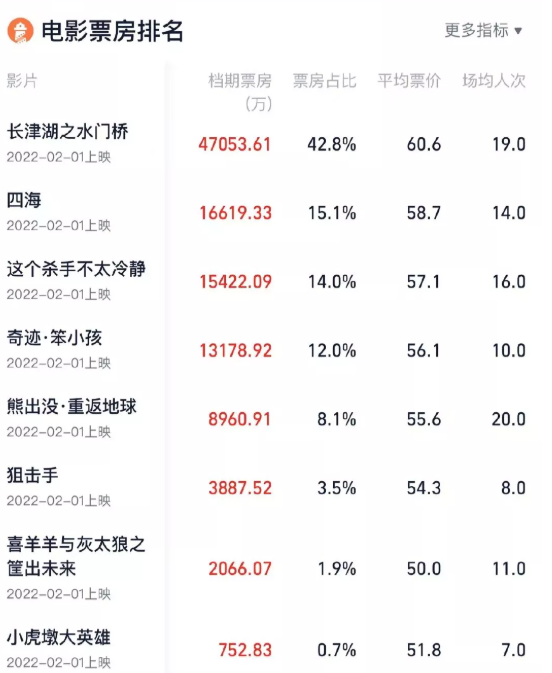杭州Discovery·西湖|登南高峰,骋望湖山幽邃
杭州,因湖而名,倚湖而兴。
西湖景致自然秀美,饱含人文灵气。在杭州人眼里,西湖就好比是这座城市的“魂灵儿”,一年四季,风光各异;一日四时,妙趣不同,一有空就要去荡荡。
6月24日“杭州西湖日”推出的《杭州Discovery·西湖》系列,不仅有耳熟能详的景点,也有尚待挖掘的秘境,带大家重新去认识、去寻找西湖的湖山佳处和人文底蕴。
今日推出——登南高峰,骋望湖山幽邃。

登南高峰
骋望湖山幽邃
在西湖十景里,“双峰插云”大概是最特别的一个,名字大家都不陌生, 但几乎从没有人真正见到过。
双峰,指的是北高峰和南高峰,两者相距约5千米。

陈中秋 摄
南宋时,两座山峰的峰顶各有古塔一座,远远望去,高耸入云,因此有“两峰插云”的景名。
到了清代,两个峰顶古塔皆毁废。康熙三十八年(1699)皇帝南巡杭州, 御题景名,改“两峰”为“双峰”。
如今“双峰插云”已很难见到,双峰本身却是极佳的登高去处。
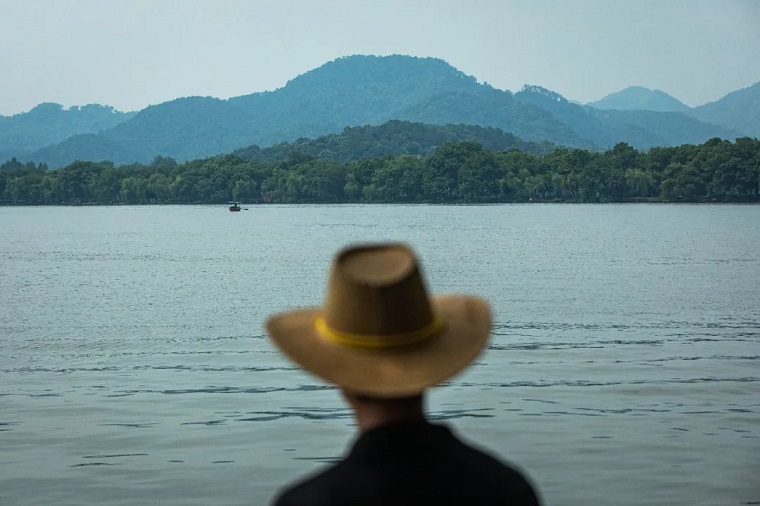
西湖边远眺南高峰(陈中秋 摄)
其中的北高峰,是西湖景区内一条经典登高线路,山巅的“天下第一财神庙”灵顺寺,常年香火鼎盛。
与它遥相呼应的南高峰,却一直是个神秘的存在,在西湖群山中也相对冷门。别说外地游客,就连很多杭州人也不一定登过南高峰顶。
听起来有点难爬的南高峰,其实不高,海拔仅257米。上南高峰的山路有很多,推荐走的是烟霞洞这条线路。
从烟霞洞公交车站出发,走过烟霞古洞,拾级而上,会路过一座颇有来历的路亭,名为陟屺亭。
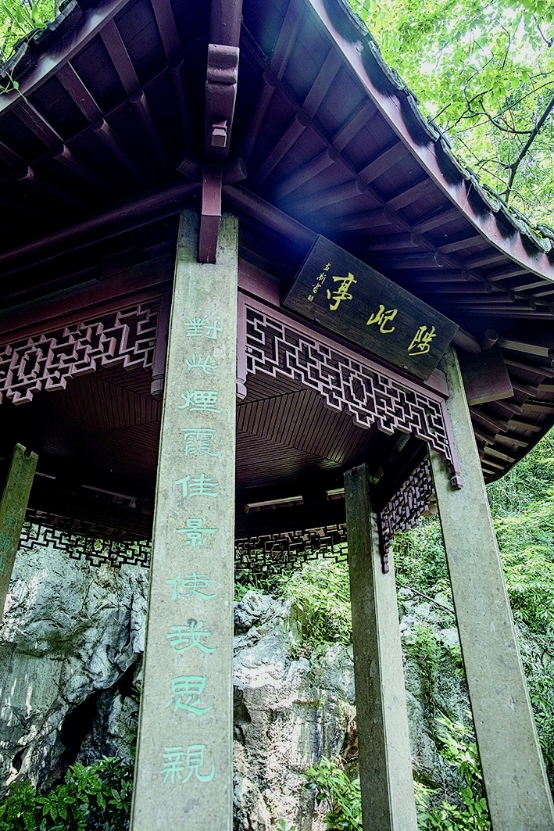
陟,登高的意思;屺,没有草木的山。不过,这里却常年林茂草盛。
陟屺两个字,出自《诗经·魏风·陟岵》:“陟彼屺兮,瞻望母兮。”意思是思念母亲。这是晚清文人金凤藻女士在1911年为寄托思母之情所建的亭子。
面对陟屺亭,有一个岔口,右手边是往山顶方向,左手边则通往一处更为低调的南高峰秘境——佛手岩。
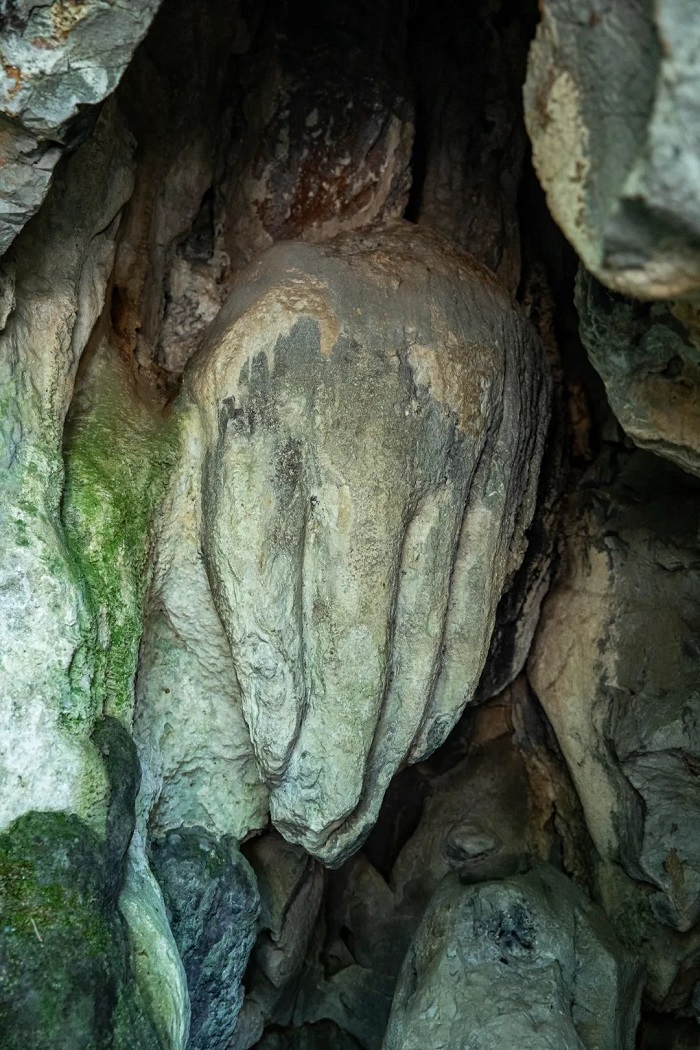
佛手岩(陈中秋 摄)
佛手岩就在烟霞洞上方的半山腰上,因为此路不通山顶,平常很少有人会来。
叫这个名字,当然不会是无缘无故的。从洞口往里看,有一块大石,如手掌下垂,筋节明晰,故得名。
佛手岩最出名的,是这里的摩崖石刻,属于古人的“朋友圈”遗存。这里一共保留了8块摩崖石刻,其中年代最早的可以追溯到北宋熙宁年间。
摩崖石刻上写着:“兖国鲁有开元翰,熙宁甲寅十月廿五日游佛手岩。”翻译过来的意思是,北宋熙宁七年,即公元1074年,农历十月廿五,山东人鲁有开,字元翰,来到佛手岩游玩。
这位鲁元翰,是北宋的一位官员,官职最高做到中大夫,从四品,相当于现在一个正厅级干部。鲁元翰是一位清官,做过许多造福老百姓的事,他的清风廉政事迹,还被写进《宋史》中。

佛手岩摩崖题刻(陈中秋 摄)
欣赏完佛手岩的摩崖石刻,继续上山登顶,需从佛手岩折返回到陟屺亭。
往下走三四分钟,是“大好湖山”石刻群。这几处摩崖石刻以民国题刻为多,有“湖山幽邃”“仿若登仙”“大好湖山”等。
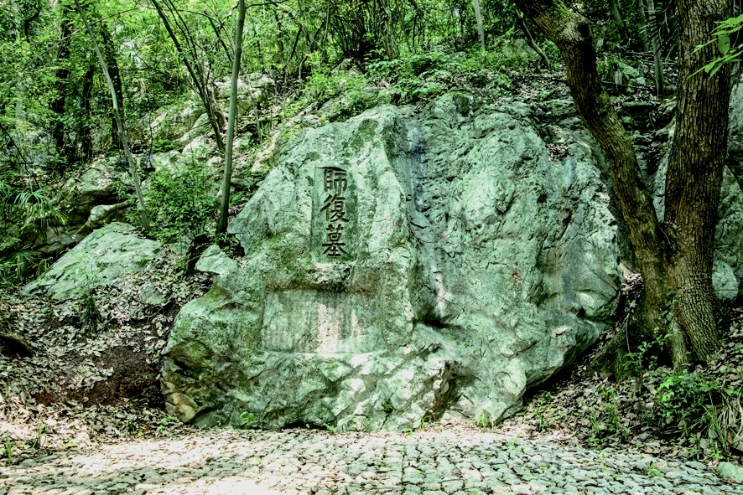
再沿着游步道一路向上,林木丛中,山壁上出现三个大字:“师复墓。”这里没有墓地,只有石壁上这三个字,下面是一篇石刻“师复墓表”。
“师复”即刘师复(又名刘思复),广东中山人。他在辛亥革命之后,目睹杂乱纷扰而注重道德救世,在杭州发起“心社”,他还是中国世界语运动的先驱之一。
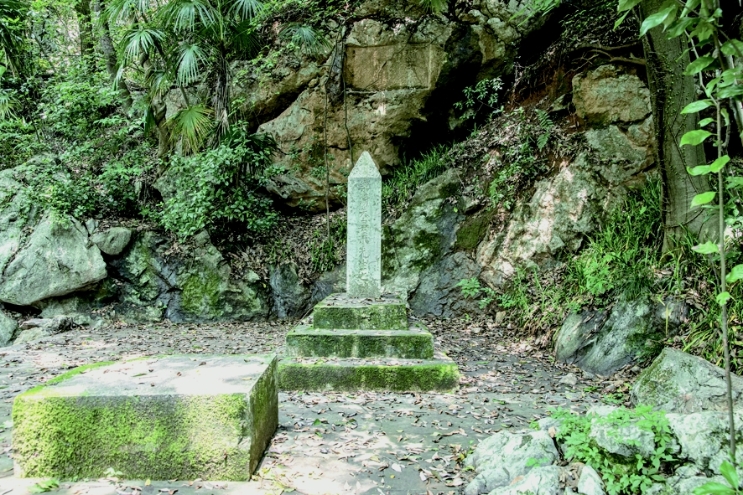
再往前,上坡,也有一座墓。墓主人叫朱昊飞,浙江乐清人,是一位化学学霸,1917年北京师范大学理化部毕业,后留学德国。朱昊飞被称为“中国染料化学之父”,历任北京大学、中山大学、武汉大学、浙江大学理化教授。
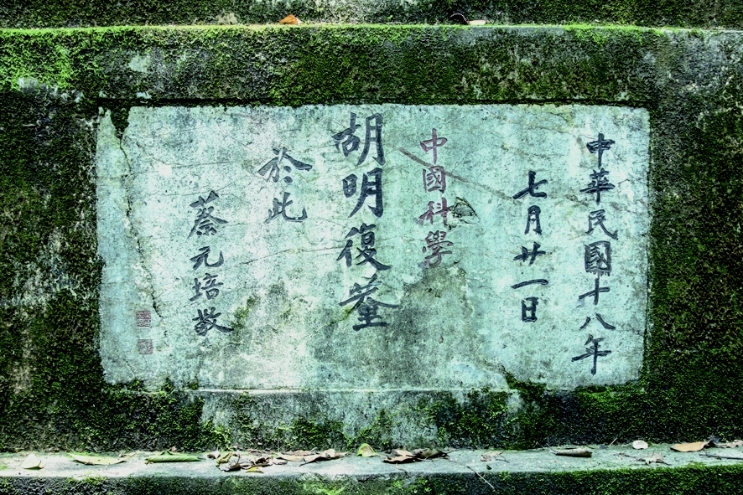
不远处,还有另一位“学霸”人物也长眠于此,胡明复,江苏无锡人。他是我国第一位现代数学博士,中国科学社的主要创始人之一,曾留学哈佛。可惜英年早逝,36岁时溺水而亡。1929年中国科学社将其遗体迁葬于烟霞岭山坡上,墓碑上的字是蔡元培题写的。
三座“学霸”墓相距不远,组合起来称为“烟霞三墓”。

南高峰洞壑众多,石径幽深(陈中秋 摄)
离开三墓,中途峰回路转,洞壑众多,上山线路不同,会看到不同的洞。比较出名的是千人洞和无门洞。
其中的千人洞,是西湖群山已知山洞中最大的洞穴,最宽敞处面积可达1300多平方米。
走上一段连续的台阶,拐弯时头顶就是悬崖峭壁,在绝壁之下有个“无门洞”,雕刻着明代时期的罗汉造像,是数百年前的民间佛教造像艺术。
再往前,过一大片茶田,就可以透过山景植被眺望远处若隐若现的钱塘江了,南高峰顶就在不远处。
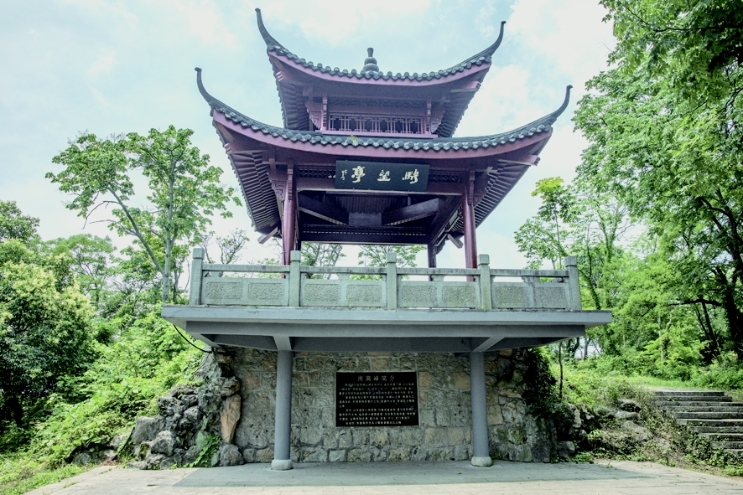
好不容易爬到山顶,又出现一座亭子,这是南高峰的最高点,骋望亭。南高峰塔遗址,就位于骋望亭东侧,现在只能看到留存的一点点塔基。

骋望远眺,可北望西湖,南望钱塘江,还可俯瞰山下的满觉陇,在杭州城内算得上是极好的一处观景点。
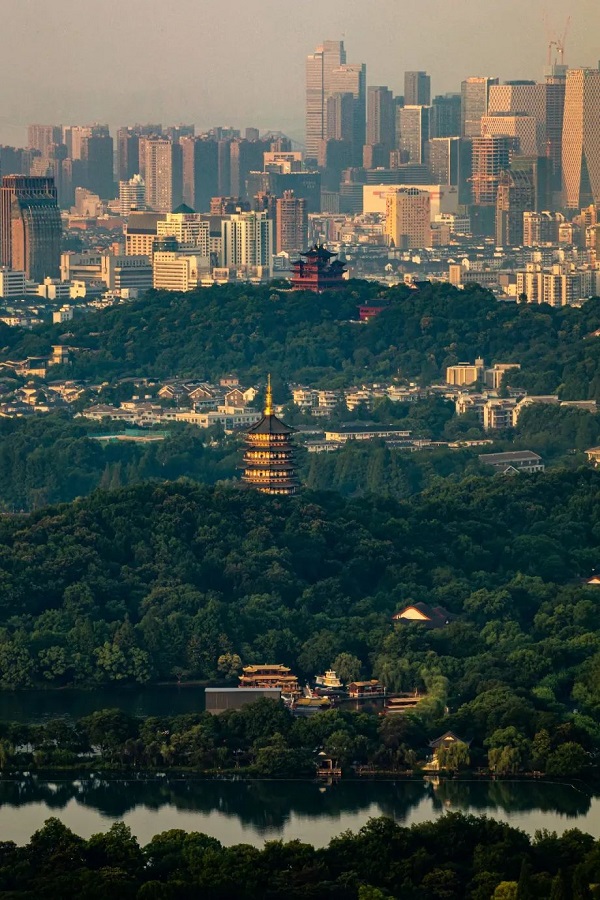
南高峰顶俯瞰城市和西湖风光(陈中秋 摄)
还有一个隐藏取景点——往下山方向走一段,会看到一个用木头搭起来的观景平台。这里不仅可以看到西湖、苏堤、小瀛洲,还能眺望远处的雷峰塔、城隍阁和城市高楼,已经成了不少摄影师拍摄杭州风光的绝佳机位。
The Southern Peak:
a "Viewing Platform" for Spectacular Sights of West Lake and Mountains
Among the ten scenic spots of West Lake, "Twin Peaks Piercing the Clouds" , a well-known scene to Hangzhou residents, is probably the most unique one as almost no one has actually seen it.
Two peaks refer to the Northern Peak and the Southern Peak, which are approximately 5 kilometers apart.
During the Southern Song Dynasty, there was an ancient pagoda at the top of each peak. On the day when the clouds and mists are lowering and from the view of West Lake, the peaks seem to get lost in an obscure manner and the spires become distinct, hence the name "Twin Peaks Piercing the Clouds" .
In the Qing Dynasty, ancient pagodas in both peaks were destroyed and abandoned. In the 38th year of the Kangxi reign (1699), the emperor conducted a southern tour of Hangzhou and renamed this scenic name from "Two Peaks" to "Twin Peaks".
Nowadays, this scenic spot is a popular destination for mountain-climbers, though it has already become a rare vision.
The Northern Peak is a classic tourist route of mountain-climbing in the West Lake Scenic Area, and the Lingshun Temple, also known as the best temple of the God of Wealth in the world, is bustling with strong incense all the year round.
The Southern Peak that echoes the northern counterpart has always been a mysterious existence and is relatively unpopular among the mountains of West Lake. Not to mention tourists from other places, even many Hangzhou residents may not have climbed it.
A bit difficult as it sounds to climb, the Southern Peak is actually not high with an elevation of only 257 meters. There are many mountain paths leading up to the Peak and here you come to the route starting from Yanxia Cave.
With the departure from the Yanxia Cave bus station, you walk slowly past the Yanxia Cave and then on the way to the Peak there stands a road pavilion with a long history called Zhiqi Pavilion.
In Chinese, "Zhi" means to climb high while "Qi" mountains without vegetation. However, it is densely wooded and overgrown with weeds.
The two characters "Zhi" and "Qi" come from the line which means "to climb a mountain without vegetation and miss my mother" in "Zhi Hu" of "Wei Feng" in The Book of Songs. This is the pavilion built in 1911 by Ms. Jin Fengzao, a scholar in the late Qing Dynasty, to express her longing for her mother.
Facing Zhiqi Pavilion, there is a fork with a track towards the peak on the right and a less-popular realm on the left, known as the Buddha's Hand Rock.
The Buddha's Hand Rock is located on the mountainside above the Yanxia Cave. There are few visitors as it is not accessible to the top of the mountain.
It is so named just for the following fact: when looking inside from the entrance of the cave, there is a large stone that looks like the palm of the hand hanging down with clear muscles, hence its name.
The most famous attraction of the Buddha's Hand Rock is the inscriptions on precipices, a sort of historical remains of ancient friends circle. A total of 8 stone carvings had been preserved here, with the earliest dating back to the Xining period of the Northern Song Dynasty.
The inscriptions on precipices are written as follows: "In the seventh year of the Xining reign of the Northern Song Dynasty (1074), Shandong native Lu Youkai, with the courtesy name Yuanhan, came to visit the Buddha's Hand Rock on the 25th day of the lunar month."
Lu Yuanhan was an official in the Northern Song Dynasty, with the highest position of sub-fourth rank official, equivalent to the current leading role of departments. He was a clean and upright official who had done many good things to benefit people, which were recorded in History of Song.
After a short stay on inscriptions on precipices, you are supposed to continue climbing further, which needs your return from the Buddha's Hand Rock to Zhiqi Pavilion.
Walking down for three or four minutes, you will find a stone carving group named "Beautiful Lakes and Mountains". These cliff stone carvings are mostly inscribed during the Republic of China, including "Secluded Lakes and Mountains", "In Resemblance to Climbing Immortals", and "Beautiful Lakes and Mountains".
If you follow the trail all the way up again, amidst the woods, there appear three large Chinese characters on the mountain wall — "Shifu Tomb". There is no cemetery here, only three characters on the stone wall. Below is a stone inscription titled "Shifu Tomb Memorial".
"Shifu" refers to Liu Shifu (also known as Liu Sifu), a native of Zhongshan, Guangdong Province, and a modern democratic revolutionist in China. After the Revolution of 1911, he focused on moral salvation after witnessing the national chaos. He launched the "Heart Society" in Hangzhou and was one of the pioneers of the Esperanto movement in China.
Going further up the slope, there is also a tomb. The owner of the tomb is Zhu Haofei, a native of Leqing, Zhejiang Province. He was a super learner on chemistry at that time, who graduated from the Department of Physics and Chemistry at Beijing Normal University in 1917 and later studied in Germany. Zhu Haofei is described as the "father of Chinese dye chemistry" and served as a professor of physics and chemistry at Peking University, Sun Yat-sen University, Wuhan University, and Zhejiang University.
Not far away, in the high grass on the left is the resting place of another "super learner", Hu Mingfu, from Wuxi, Jiangsu Province. He is the first doctor of modern mathematics in China, one of the main founders of the Chinese Science Society, and once studied at Harvard University. Unfortunately, he drowned untimely at the age of 36. In 1929, the Chinese Science Society relocated him to the Yanxia Ridge, with the inscription on the tombstone written by Cai Yuanpei.
The three tombs are not far apart, and this is the famous scenic spot "Yanxia Three Tombs".
On the way from "Yanxia Three Tombs" towards the peak, there are a variety of caves and you are likely to have different cave views depending on different routes up the mountain. Among the famous ones are the "Thousand People Cave" and the "Doorless Cave".
The "Thousand People Cave" is the largest cave in mountains around West Lake, with the widest area reaching over 1,300 square meters.
With continuous steps onward, there comes the cliff on the top of the head when turning. Right under the cliff is the "Doorless Cave", carved with several Arhat statues in the Ming Dynasty, which is a folk Buddhist statue art hundreds of years ago.
Further ahead, after passing a large tea field, you can overlook the indistinct Qiantang River through mountains and vegetations, and the Southern Peak is not far away.
After you finally reach the top of the mountain, there appears another pavilion — the Chengwang Pavilion, which is the highest point of the Peak. The site of the Southern Peak Pagoda is located on the east side of the Chengwang Pavilion, and only a small part of the tower base is visible.
When looking far into the distance from the Chengwang Pavilion, it can be discovered that West Lake is in the north, the Qiantang River in the south, and Manjuelong (a valley in Hangzhou, famous for its osmanthus flowers) at the foot of the mountain. It is an excellent viewing spot in Hangzhou.
In fact, there is also another hidden viewing spot — walking down the mountain, you will find a viewing platform built out of wood.
Here, you can not only have a panoramic view of West Lake, Su Causeway and Lesser Yingzhou, but also overlook the Leifeng Pagoda, Chenghuang Pavilion, and urban high buildings in the distance. It has already become an excellent position for many photographers to capture the scenery of Hangzhou.
▼延伸阅读▼
声明:
本文仅代表作者个人观点,与新江南网无关。其原创性以及文中陈述文字和内容未经本站证实,对本文以及其中全部或者部分内容、文字的真实性、完整性、及时性本站不作任何保证或承诺,请读者仅作参考,并请自行核实相关内容。
- 衣锦归来 吴越同欢!追忆临安繁华老街的“前09-14
- 栾树开花秋风起,打卡杭州秋色叶的“先锋官09-14
- 教师节,略谈《孔子圣迹图》09-10
- 凌晨3点,他们陪你一起等待“最美西湖日出”09-10
- 冲破关山千万重——写在杭温高铁开通之际09-09
- Freestyle?老奶奶用古老的讲唱宣传《垃圾分09-09
- 悟空:英雄只此敢争先09-06
- 建德市:育强“新农人”,以人才“美”业赋09-06
- 塘栖水北,往来明月里09-06
阅读推荐
新闻爆料

